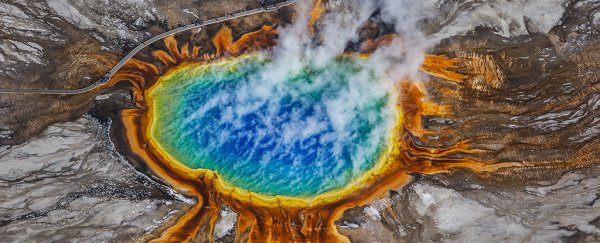Scientists have found a new lineage of microbes in the famously hot and acidic spring waters of Yellowstone National Park in the US, a discovery that promises to teach us more about the origins of life on our planet.
These single-cell organisms, from the archaea domain of life, seem to thrive in the thermal springs of Yellowstone where iron oxide is the main mineral.
Because the surface of Mars is made up of the same sort of materials, the researchers have named the lineage Marsarchaeota.
The conditions inside the springs of Yellowstone are thought to match the conditions on the early Earth, and that's why these Marsarchaeota microbes can be so helpful – they can show us how organisms sparked into life, and what role iron oxide may have played.
"The discovery of archaeal lineages is critical to our understanding of the universal tree of life and evolutionary history of Earth," write the researchers.
"The broad distribution of Marsarchaeota in geothermal, microaerobic iron oxide mats suggests that similar habitat types probably played an important role in the evolution of archaea."
Using a variety of techniques - including microscopic analysis and genome sequencing - the team studied microbial mats in Yellowstone Park springs that are about as acidic as grapefruit juice.
Two groups of Marsarchaeota were identified, one living in temperatures above 50 degrees Celsius (122 degrees Fahrenheit) and the other living in temperatures between 60 and 80 degrees Celsius (140 to 176 degrees Fahrenheit).
Samples were taken from across Yellowstone Park, with these archaea lineages sometimes making up as much as half the organisms inside a single microbial mat.
The mats themselves have been turned red by the iron oxide, which also slows the passage of water across the top of the mats. Oxygen is captured from the atmosphere and supplied to the Marsarchaoeta as water trickles over them – though the microbes are very deep, they only require low levels of oxygen.
"Physics comes together with chemistry and microbiology," says senior researcher William Inskeep, from Montana State University. "It's like a sweet spot of conditions that this group of organisms likes."
By adding these archaea to "the universal tree of life", we can get a better idea of the ancient organisms that first sprung up on the planet, and maybe then answer the broader question of how they evolved into multi-celled eukaryotes – animals and plants.
One idea is that these Marsarchaeota might be involved in converting iron into a simpler form. They don't produce iron oxide themselves, as other microbes do.
"Iron cycling has been implicated as being extremely important in early Earth conditions," says Inskeep.
More close observation will be required to figure out how this particular type of microbe can flourish in these conditions, and what its role might have been before any other type of life appeared on Earth.
And the potential benefits to science don't end there. Further down the line these microorganisms could give us more clues about how life is potentially surviving on Mars, as well as some of the fundamentals about biology at higher temperatures.
"Knowing about this new group of archaea provides additional pieces of the puzzle for understanding high-temperature biology," says Inskeep.
"That could be important in industry and molecular biology."
The research has been published in Nature Microbiology.
